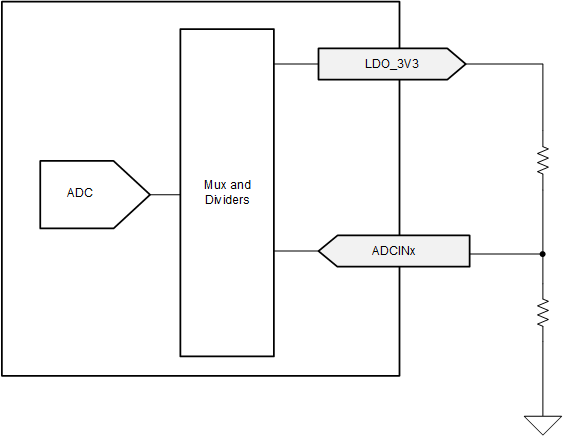SLVSG37 June 2021 TPS65994AE
PRODUCTION DATA
- 1 Features
- 2 Applications
- 3 Description
- 4 Revision History
- 5 Pin Configuration and Functions
-
6 Specifications
- 6.1 Absolute Maximum Ratings
- 6.2 ESD Ratings
- 6.3 Recommended Operating Conditions
- 6.4 Recommended Capacitance
- 6.5 Thermal Information
- 6.6 Power Supply Characteristics
- 6.7 Power Consumption
- 6.8 PP_5V Power Switch Characteristics
- 6.9 PP_EXT Power Switch Characteristics
- 6.10 Power Path Supervisory
- 6.11 CC Cable Detection Parameters
- 6.12 CC VCONN Parameters
- 6.13 CC PHY Parameters
- 6.14 Thermal Shutdown Characteristics
- 6.15 ADC Characteristics
- 6.16 Input/Output (I/O) Characteristics
- 6.17 I2C Requirements and Characteristics
- 6.18 Typical Characteristics
- 7 Parameter Measurement Information
-
8 Detailed Description
- 8.1 Overview
- 8.2 Functional Block Diagram
- 8.3
Feature Description
- 8.3.1 USB-PD Physical Layer
- 8.3.2 Power Management
- 8.3.3
Power Paths
- 8.3.3.1
Internal Sourcing Power Paths
- 8.3.3.1.1 PP_5Vx Current Clamping
- 8.3.3.1.2 PP_5Vx Local Overtemperature Shut Down (OTSD)
- 8.3.3.1.3 PP_5Vx Current Sense
- 8.3.3.1.4 PP_5Vx OVP
- 8.3.3.1.5 PP_5Vx UVLO
- 8.3.3.1.6 PP_5Vx Reverse Current Protection
- 8.3.3.1.7 Fast Role Swap
- 8.3.3.1.8 PP_CABLE Current Clamp
- 8.3.3.1.9 PP_CABLE Local Overtemperature Shut Down (OTSD)
- 8.3.3.1.10 PP_CABLE UVLO
- 8.3.3.2 Sink Path Control
- 8.3.3.1
Internal Sourcing Power Paths
- 8.3.4 Cable Plug and Orientation Detection
- 8.3.5 Default Behavior Configuration (ADCIN1, ADCIN2)
- 8.3.6 ADC
- 8.3.7 DisplayPort Hot-Plug Detect (HPD)
- 8.3.8 Digital Interfaces
- 8.3.9 Digital Core
- 8.3.10 I2C Interface
- 8.4 Device Functional Modes
- 9 Application and Implementation
- 10Power Supply Recommendations
- 11Layout
- 12Device and Documentation Support
- 13Mechanical, Packaging, and Orderable Information
Package Options
Mechanical Data (Package|Pins)
- RSL|48
Thermal pad, mechanical data (Package|Pins)
- RSL|48
Orderable Information
8.3.5 Default Behavior Configuration (ADCIN1, ADCIN2)
This functionality is firmware controlled and subject to change.
The ADCINx inputs to the internal ADC control the behavior of the TPS65994AE in response to PA_VBUS or PB_VBUS being supplied when VIN_3V3 is low (that is the dead-battery scenario). The ADCINx pins must be externally tied to the LDO_3V3 pin via a resistive divider as shown in the following figure. At power-up the ADC converts the ADCINx voltage and the digital core uses these two values to determine start-up behavior. The available start-up configurations include options for I2C slave address of I2C_EC_SCL/SDA, sink path control in dead-battery, and default configuration.
 Figure 8-17 ADCINx Resistor Divider
Figure 8-17 ADCINx Resistor DividerThe device behavior is determined in several ways depending upon the decoded value of the ADCIN1 and ADCIN2 pins. The following table shows the decoded values for different resistor divider ratios. See Pin Strapping to Configure Default Behavior for details on how the ADCINx configurations determine default device behavior. See I2C Address Setting for details on how ADCINx decoded values affects default I2C slave address.
| DIV = RDOWN / (RUP + RDOWN)(1) | Without using RUP or RDOWN | ADCINx decoded value | ||
|---|---|---|---|---|
| MIN | Target | MAX | ||
| 0 | 0.0114 | 0.0228 | tie to GND | 0 |
| 0.0229 | 0.0475 | 0.0722 | N/A | 1 |
| 0.0723 | 0.1074 | 0.1425 | N/A | 2 |
| 0.1425 | 0.1899 | 0.2372 | N/A | 3 |
| 0.2373 | 0.3022 | 0.3671 | N/A | 4 |
| 0.3672 | 0.5368 | 0.7064 | tie to LDO_1V5 | 5 |
| 0.7065 | 0.8062 | 0.9060 | N/A | 6 |
| 0.9061 | 0.9530 | 1.0 | tie to LDO_3V3 | 7 |